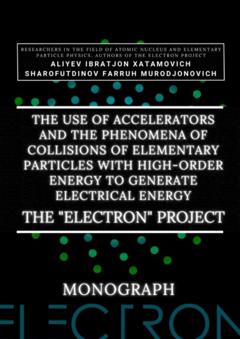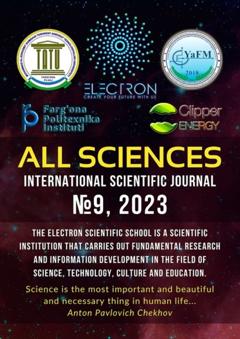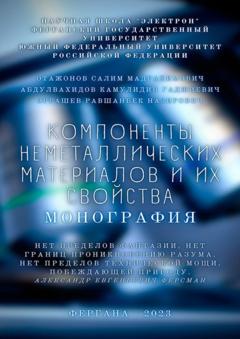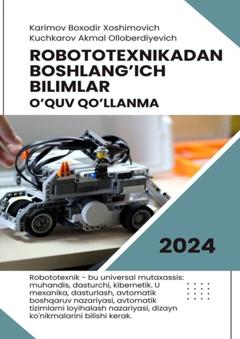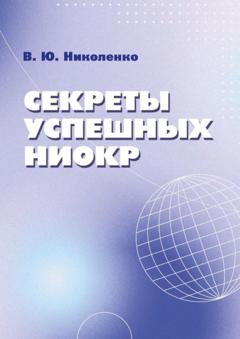The use ofВ accelerators and the phenomena ofВ collisions ofВ elementary particles with high-order energy toВ generate electrical energy. The В«ElectronВ» Project. Monograph
Farruh Murodjonovich Sharofutdinov
Ibratjon Xatamovich Aliyev
The monograph presents an introductory part to the physics of resonant nuclear reactions, describes a study on the use of 6 nuclear reactions on accelerators as an energy source. A installation operating on this principle and being a solution to the problem of a global shortage of electrical energy is described. The book is addressed to all researchers in the field of the nuclear reactions, university teachers, masters, students and anyone interested in the future of progress and science.
The use ofВ accelerators and the phenomena ofВ collisions ofВ elementary particles with high-order energy toВ generate electrical energy. The В«ElectronВ» Project
Monograph
Ibratjon Xatamovich Aliyev
Farruh Murodjonovich Sharofutdinov
Editor Boxodir Xoshimovich Karimov
Editor Farruh Murodjonovich Sharofutdinov
Illustrator Ibratjon Xatamovich Aliyev
Cover design Ibratjon Xatamovich Aliyev
Cover design Farruh Murodjonovich Sharofutdinov
Reviewer, Doctor of Technical Sciences, Professor of the Scientific Research Institute "Physics of Semiconductors and Microelectronics" at the National University of Uzbekistan Obbozjon Xokimovich Qo'ldoshev
Reviewer, Doctor of Physical and Mathematical Sciences, Professor and Head of the Department of "Technological Education" of the Faculty of Physics and Technology of Fergana State University Salim Madraximovich Otajonov
Reviewer, Candidate of Physical and Mathematical Sciences, Associate Professor of the Department of "Technological Education" of the Faculty of Physics and Technology of Fergana State University Boxodir Xoshimovich Karimov
Reviewer, Candidate of Physical and Mathematical Sciences, Associate Professor of the Faculty of Computer Design Systems of the Fergana Polytechnic Institute Sultonali Mukaramovich Abduraxmonov
Reviewer, Doctor of Philosophy in Physical and Mathematical Sciences, Senior Lecturer at the Faculty of Physics and Mathematics of Ferghana State University Sapura Malikovna Zaynolobidinova
Reviewer, lecturer at the Faculty of Physics and Mathematics of Fergana State University Dilshod Quldoshaliyevich Yuldoshaliyev
Pedagogical consultant on the 1st section, Candidate of Philosophical Sciences, Associate Professor of the Department of Sociology of Fergana State University Baxromjon Nomonjonov
Pedagogical consultant on the 1st section, Candidate of Pedagogical Sciences, Associate Professor of the Department of Information Security of the Fergana Branch of the Tashkent University of Information Technologies Inomjon Uktamovich Bilolov
Consultant in Physical Sciences Abdurasul Abdusoliyevich Ergashev
Proofreader Ibratjon Xatamovich Aliyev
Proofreader Gulnoza Muxtarovna Sobirova
Proofreader Abdurasul Abdusoliyevich Ergashev
© Ibratjon Xatamovich Aliyev, 2023
© Farruh Murodjonovich Sharofutdinov, 2023
ISBNВ 978-5-0059-5377-3
Created with Ridero smart publishing system
Preface
Our world is immersed in a huge ocean of energy, we are flying in infinite space at an incomprehensible speed. Everything is spinning, moving – all the energy. We have a huge task ahead of us – to find ways to extract this energy. Then, extracting it from this inexhaustible source, humanity will move forward with giant strides!
В В В В Nikola Tesla
Energy has been important for all mankind since ancient times. Every day a person consumes more and more energy, and if earlier the main source of energy was fire, today its role is increasingly being performed by electric current. With the help of electricity, lamps are lit, computers work, books are printed, food is heated and cars are already driving. Electricity has entered into all corners of human life and is an essential resource.
For the first time, work on the generation of electric current began with experiments on the study of electromagnetic induction by Michael Faraday, but for a long time these works were not implemented in the face of industrial plants and installations. Initially, only steam engines were used to perform certain work by James Watt, and only after the invention of the armature winding of dynamoelectric machines by the Belgian Zenob Theophil Gram in 1871, it became possible to obtain electric current industrially.
Thus, the first power station was a hydroelectric power station, created in 1878 by an English engineer, Baron William Armstrong at his estate Cragside, in England. The generated electricity was used for lighting, heating, hot water supply and other household work.
But for the people and all mankind, electricity began to serve only 4 years later, in the winter of January 12, 1882, in London, when the world's first public coal-fired electric power station by Thomas Edison, built according to his own project, started working. Since then, mankind has been industrially using electric current, of course, a lot has already changed since then, the technologies of the famous inventor Nikola Tesla have been introduced to use alternators, as in power transmission systems, on the same basis of alternating current.
But also, in order to satisfy their needs, man has invented a number of methods and technologies for obtaining and generating electric current on a large scale. But are all these methods so safe and do they manage to fully perform their function?
To date, to generate electric current and meet the needs of mankind in this resource, technologies for generating electric energy from heat (steam pressure) are used, which is clearly expressed in the technologies of thermal power plants (thermal power plants), where by burning coal, natural gas and other combustible resources having some energy potential in their structure, they receive steam that creates sufficient pressure for the movement of steam generator turbines, which, using the phenomenon of electromagnetic induction, converts kinetic energy (energy of motion, in this case, the energy of rotation, turbines under the action of steam force), that is, the force of steam pressure into an electric current that is already transmitted through power lines (power lines) to consumers for further use.
Also, hydroelectric power plants (hydroelectric power plants), nuclear power plants (nuclear power plants), wind farms (wind farms), SPES (solar panel power plants) are used as sources of electric energy. Other technologies are also known, such as methods of obtaining current from lightning, waves and other natural forces, but they are not used on a large scale, for this reason it is enough to consider only the above types of power plants, with their own methods of generating large electrical energy.
The TPP technology was considered, if we stop at the HPP, then this power plant is based on generating an electric current from kinetic, and in the case of being at a high altitude, potential (energy that an object possesses, being at a certain height due to gravitational force or gravity, while potential energy is involved with a further transition to kinetic) energy water and rotation of the generator turbines at high speed and subsequent generation of electric current, also using the phenomenon of electromagnetic induction, on which the principles of all electric generators are based.
The next type of power plant, namely nuclear power plants, are stations whose principle is based on one of the most progressive and newest methods of generating electric energy, namely, on the basis of generating electric current from atomic energy, which is released after the decay of uranium—235 or uranium-238 nuclei, depending on the type of station after they are bombarded with thermal (having an energy that is numerically equal to the energy at normal temperature) by neutrons. Due to the fact that after each subsequent reaction, a maximum of 3, and more often 2 additional neutrons are released, a chain reaction occurs with the release of 200 MeV, with each reaction, with a rapid increase in the total energy of the body, which leads to an increase in temperature.
And at the same time, there comes a moment when there is enough energy to transfer it to water, which is irradiated and transfers heat to the second water circuit, through which the already circulating water rotates steam generators, while the temperature does not reach critical temperatures, due to the fact that the water is under pressure, which increases the levels of constant temperatures for this liquid.
Describing the wind farm, it is worth noting that the principle of electromagnetic induction is also preserved there and more than one generator is used, which rotate under the force of the wind, although they rotate with a lower frequency, respectively generating less power.
The final one, also becoming more popular and relevant every day, is the SPES. This type of station by the method of generating electric current is radically different from the others. This type of stations is based on the phenomenon of photoelectronic emission, which occurs when specially manufactured panels are irradiated with sunlight, the electric charge generated in this case is output and transferred already to the transmission lines.
But it is also worth noting that each type of power plants has significant disadvantages, of course not in its design, but in the effect exerted on nature and the environment. For example, thermal power plants [8] generate a huge amount of anhydride carbonate, which is released into the atmosphere and causes such an effect, which is referred to as global warming, which is a consequence of the so-called greenhouse effect.
We will describe all these problems for the following power plants:
hydroelectric power plants [9]:
В· Disaster risk (difficult construction in case of earthquakes and other natural disasters);
В· Danger of fish migration (whole species of various fish may die);
В· Danger of nearby cities (in case of a problem with the plate within a radius of many kilometers, cities will be flooded).
NPP [10]:
В· Uranium is a non-renewable resource;
В· Cannot replace fossil fuels;
В· Depends on fossil fuels;
В· Uranium mining is harmful to the environment;
В· Very persistent waste, decomposed for a long time;
В· The danger of nuclear disasters;
В· The presence of the effect of changing the planetary radioactive background;
В· High explosion hazard;
В· Difficulty of recovery, in the event of a disaster.
WES [11]:
В· Presence of noise;
В· High cost of buildings;
В· Long payback period in case of implementation;
В· Inconstancy and unregulated wind flow;
В· Low energy efficiency.
SPES [12]:
В· Lack of energy extraction at night;
В· High energy storage costs;
В· Relatively high price of solar cells;
В· Daily and seasonal variability of solar radiation;
В· Local climatic changes unfavorable for the use of solar energy;
В· Difficulties with accumulation and concentration of energy;
В· The daily energy flux density of solar radiation is low;
В· Installation takes up large areas;
В· High production and construction costs;
В· Low generated power.
Analyzing the above facts, it becomes clear that a development is needed that can generate electric current with greater efficiency, on a larger scale, and also more safely than with the help of technologies used today. And if we consider all possible ways of obtaining electrical energy, then there is an explanation for why this study, which has been going on for more than 12 years, was so called – "Electron".
Initially, the search for a new source of electrical energy began back in 2010. The first stage of the study was to search for such a method in classical mechanisms. More than 500 different mechanisms were analyzed, but all of them were not effective until the first magnetic type of device was presented for the first time in 2016, which, using the force of magnetic repulsion, created vibrations that caused the output of 3—4 water jets, the potential energy of which was converted into electric current. But this version of the device was not strong enough and effective enough, and after an experimental test, a number of shortcomings were found, which caused the rejection of this model.
This was followed byВ 34В mechanisms, which distinguished themselves byВ following the first more successful version. But when they did not find their confirmation, it was necessary toВ abandon them. For 4В years, since 2014, the so-called В«electric eraВ» has been going on, when various mechanisms ofВ an electric, magnetic and electromagnetic nature were investigated. And although mechanisms with electric generators, solar panels, transformers, diodes, transistors and many other elements have been developed, but, unfortunately, they have not found their confirmation. Then, starting inВ 2019, the В«quantum eraВ» began.
In March 2019, the first project with elementary particles was developed, and then the project changed its own name and adopted the name "Electron", since the idea was based on splitting an electron and conducting interactions with the creation of a special "structure" already with hypothetical components of the electron particle. Due to this, the components in the face of Umidon and Raanon particles were studied in detail. Then for the first time scientific articles on this topic were published: "Behavior of an electron in an atom", "Electron particle", "Electron features", "Linear Electron Accelerator in Power engineering" and many others. They also took part in the international event InnoWeek 2019.
